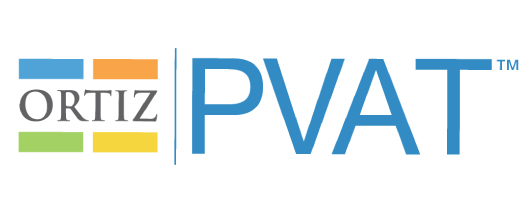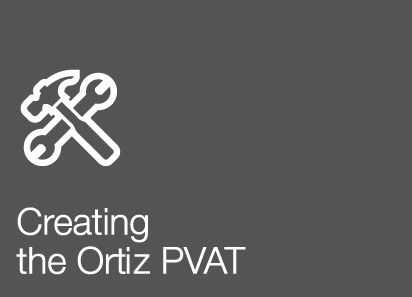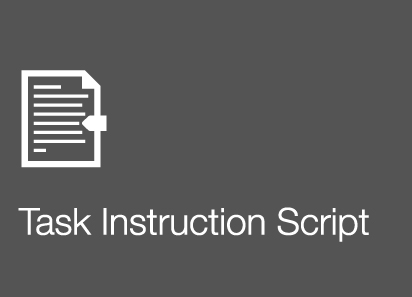Ortiz PVAT Technical Manual References |
American Educational Research Association (AERA), American Psychological Association (APA), & National Council on Measurement in Education (NCME). (2014). Standards for Educational and Psychological Testing. Washington, D.C.: AERA.
American Psychiatric Association. (2000). Diagnostic and statistical manual of mental disorders (4th ed., text revision). Washington, D.C.: American Psychiatric Association.
American Psychiatric Association. (2013). Diagnostic and statistical manual of mental disorders (5th ed.). Washington, D.C.: American Psychiatric Association.
American Speech-Language-Hearing Association. (2004). Preferred practice patterns for the profession of speech-language pathology [Preferred Practice Patterns]. Retrieved from http://www.asha.org/policy/PP2004-00191/
Angoff, W. H., & Robertson, G. J. (1987). A procedure for standardizing individually administered tests, normed by age or grade level. Applied Psychological Measurement, 11, 33–46. doi:10.1177/014662168701100102
Ayearst, L. E., & Bagby, R. M. (2010). Evaluating the psychometric properties of psychological measures. In M. M. Anthony & D. H. Barlow (Eds.), Handbook of assessment and treatment planning for psychological disorders (2nd ed., pp. 31–40). New York, NY: Guilford.
Board of Regents of the University of Wisconsin System. (2009). WIDA ACCESS for ELLs 2.0. Madison, WI: Author.
Bracken, B. A. (1987). Limitations of preschool instruments and standards for minimal levels of technical adequacy. Journal of Psychoeducational Assessment, 4, 313–326.
Brown, J. E., & Ortiz, S. O. (2014). Interventions for English learners with learning difficulties. In J. T. Mascolo, V. C. Alfonso, & D. P. Flanagan (Eds.), Essentials of planning, selecting, and tailoring interventions for unique learners (pp. 267–313). Hoboken, NJ: Wiley & Sons.
California Department of Education (CDE). (2016). California English Language Development Test (CELDT) 2016–17 Edition. Sacramento, CA: CDE.
Carroll, J. B. (1993). Human cognitive abilities: A survey of factor analytic studies. New York, NY: Cambridge University Press.
Cattell, R. B. (1943). The measurement of adult intelligence. Psychological Bulletin, 2, 153–193.
Chalmers, R. P. (2012). mirt: A Multidimensional Item Response Theory package for the R environment [R package version 1.17.1]. Journal of Statistical Software, 48(6), 1–29.
Chalmers, R. P., Counsell, A., & Flora, D. B. (2016). It might not make a big DIF: Improved Differential Test Functioning statistics that account for sampling variability. Educational and Psychological Measurement, 76(1), 114–140. doi:10.1177/0013164415584576
Cohen, J. (1988). Statistical power analysis for the behavioral sciences. Hillsdale, NJ: Lawrence Erlbaum Associates.
Crocker, L., & Algina, J. (1986). Introduction to classical and modern test theory. New York: NY: Harcourt.
Cronbach, L. J. (1951). Coefficient alpha and the internal structure of tests. Psychometrika, 16, 297–335. doi:10.1007/BF02310555
Cummins, J. (1981). Age on arrival and immigrant second language learning in Canada: A reassessment. Applied Linguistics, 11, 132–149.
Cummins, J. (1984). Bilingualism and special education: Issues in assessment and pedagogy. San Diego, CA: College-Hill.
Davies, M. (2009). Frequency dictionary of American English. Provo, UT: Brigham Young University. Retrieved from http://www.wordfrequency.info/intro.asp
Dolch, E. W. (1948). Problems in reading. Retrieved from http://www.sightwords.com/sight-words/dolch/
Dunn, L. M., & Dunn, D. M. (2007). Peabody Picture Vocabulary Test, Fourth Edition. San Antonio, TX: Pearson, Inc.
Embretson, S. E., & Reise, S. P. (2000). Item Response Theory for psychologists. Mahwah, NJ: Lawrence Erlbaum Associates Publishers.
Essberger, J. (2012). English preposition list. Cambridge, UK: English Club. Retrieved from http://www.englishclub.com/
Fassold, M. A. J. (2000). Disparate impact analyses of TAAS scores and school quality. Hispanic Journal of Behavioral Sciences, 22, 460–480. doi:10.1177/0739986300224006
Flanagan, D. P., Fiorello, C. A., & Ortiz, S. O. (2010). Enhancing practice through the application of Cattell-Horn-Carroll Theory and research: A “third method” approach to specific learning disability identification. Psychology in the Schools, 47, 739–760. doi:10.1177/0022219412453172
Flanagan, D. P., Ortiz, S. O., & Alfonso, V. C. (2013). Essentials of cross-battery assessment (3rd ed.). Hoboken, NJ: John Wiley & Sons, Inc.
Flannery, W. P., Reise, S. P., & Widaman, K. F. (1995). An Item Response Theory analysis of the general and academic scales of the Self-Description Questionnaire II. Journal of Research in Personality, 29(2), 168–188. doi:10.1006/jrpe.1995.1010
Fromkin, V., Rodman, R., & Hyams, N. (2014). An introduction to language. Boston, MA: Wadsworth Cengage Learning.
Gibson, T. A., Peña, E. D., & Bedore, L. M. (2014a). The receptive-expressive gap in bilingual children with and without primary language impairment. American Journal of Speech-Language Pathology, 23(4), 655–667. doi:10.1055/2014_AJSLP-12-0119
Gibson, T. A., Peña, E. D., & Bedore, L. M. (2014b). The relation between language experience and receptive-expressive semantic gaps in bilingual children. International Journal of Bilingualism and Bilingual Education, 17, 90–110.
Goldenberg, C. (2008). Teaching English language learners: What the research does—and does not—say. American Educator, 32(2), 8–44.
Goldenberg, C. (2013). Unlocking the research on English learners: What we know—and don’t know—about effective instruction. American Educator, 37(2), 4–39.
Hart, B., & Risley, T. R. (2003). The early catastrophe: The 30 million word gap by age 3. Education Review, 17(1), 110–118.
The Health Insurance Portability and Accountability Act of 1996 (HIPAA). Pub. L. 104–191. Stat. 1936. Web. 11 Aug. 2014.
Horn, J. L. (1998). A basis for research on age differences in cognitive capabilities. In J. J. McArdle & R. Woodcock (Eds.), Human cognitive abilities in theory and practice. Mahwah, NJ: Erlbaum.
IBM Corp. (2012). IBM SPSS Statistics for Windows, version 22.0. Armonk, NY: IBM Corp.
Individuals with Disabilities Education Act (IDEA), 20 U.S.C. § 1400 (2004).
John, O.P., & Benet-Martínez, V. (2000). Measurement, scale construction, and reliability. In H.T. Reis and C.M. Judd (Eds.), Handbook of research methods in social and personality psychology (pp. 339–369). New York, NY: Cambridge University Press.
k12reader.com. (2011). Grade level spelling words. Retrieved from http://www.k12reader.com/first-grade-spelling-words/
Karansinski, C., & Anderson, K. (2017). Third grade and concurrent predictors of engagement and achievement in reading in eighth grade. Speech, Language and Hearing. Advance online publication. doi:10.1080/2050571X.2017.1290739
Kaufman, A. S. (1994). Intelligent testing with the WISC-III. Hoboken, NJ: Wiley & Sons, Inc.
Kolen, M. J., & Brennan, R. L. (2014). Test equating, scaling, and linking (3rd ed.). New York, NY: Springer.
Krashen, S. D. (1982). Principles and practice in second language acquisition. New York, NY: Pergamon Press.
Lenhard, A., Lenhard, W., Suggate, S., & Segerer, R. (2016). A continuous solution to the norming problem. Assessment. Advance online publication. doi:10.1177/1073191116656437
Lohman, D. F., Korb, K. A., & Lakin, J. M. (2008). Identifying academically gifted English-language learners using nonverbal tests: A comparison of the Raven, NNAT, and CogAT. Gifted Child Quarterly, 52(4), 275–296. doi:10.1177/0016986208321808
Lord, F. M. & Novick, M. R. (1968). Statistical theories of mental test scores. Reading, MA: Addison-Welsley Publishing Company.
MacKenzie, S. B., Podsakoff, P. M., & Podsakoff, N. P. (2011). Construct measurement and validation procedures in MIS and behavioral research: Integrating new and existing techniques. MIS Quarterly, 35(2), 293–334.
Merriam-Webster. (2003). Merriam-Webster’s collegiate dictionary (11th ed.). Springfield, MA: Author.
Milton, J. (2009). Measuring second language vocabulary acquisition. Tonawanda, NY: Multilingual Matters.
Morgan, K., Johnson, A. J., & Miles, C. (2013). Chewing gum moderates the vigilance decrement. British Journal of Psychology, 105(2), 214–225. doi:10.1111/bjop.12025
Nunnally, J. C., & Bernstein, I. H. (1994). Psychometric theory (3rd ed.). New York, NY: McGraw-Hill.
O’Conner, B. P. (2016). paramap: Factor analysis functions for assessing dimensionality. R package version 1.1. Retrieved from https://people.ok.ubc.ca/brioconn/nfactors/paramap_1.1.tar.gz/
Ortiz, S. O. (2014). Best practices in nondiscriminatory assessment. In P. Harrison & A. Thomas (Eds.), Best practices in school psychology VI: Foundations (pp. 61–74). Bethesda, MD: National Association of School Psychologists.
Ortiz, S. O., Flanagan, D. P., & Alfonso, V. C. (2017). Cross-Battery Assessment Software System, Version 2.0 (X-BASS v2.0). Hoboken, NJ: Wiley & Sons, Inc.
Pearson, P. D., Hiebert, E. H., & Kamil, M. L. (2007). Vocabulary assessment: What we know and what we need to learn. Reading Research Quarterly, 42, 282–296. doi:10.1598/RRQ.42.2.4.
Peña, E. D., Gutiérrez-Clellen, V. F., Iglesias, A., Goldstein, B. A., & Bedore, L. M. (2014). BESA: Bilingual English-Spanish Assessment. San Rafael, CA: AR-Clinical Publications.
Personal Information Protection and Electronic Documents Act, SC 2000, c 5. Retrieved from http://canlii.ca/t/52hmg
Quinn, J. M., Wagner, R. K., Petsher, Y., & Lopez, D. (2015). Developmental relations between vocabulary knowledge and reading comprehension: A latent change score modeling study. Child Development, 86, 159–175. doi:10.1111./cdev.12292
R Core Team (2013). R: A language and environment for statistical computing. Vienna, Austria: R Foundation for Statistical Computing. Retrieved from http://www.R-project.org/
Rhodes, R. L., Ochoa, S. H., & Ortiz, S. O. (2005). Assessing culturally and linguistically diverse students: A practical guide. New York, NY: Guilford Press.
Rogerson, H. D., & Menasche, L. (Eds.). (1988–2004). Words for students of English: A vocabulary series for ESL (Vols. 1–8). Pittsburgh, PA: University of Pittsburgh Press and the English Language Institute, University of Pittsburgh.
Roid, G. H. (1983, August). Generalization of continuous norming: Cross-validation of test-score mean estimates. Paper presented at the meeting of the American Psychological Association, Anaheim, CA.
Sanford, A. K., Brown, J., & Turner, M. (2012). Enhancing instruction for English learners in response to intervention systems: The PLUSS model. Multiple Voices for Ethnically Diverse Exceptional Learners, 13(1), 56–70.
Sattler, J. M. (2001). Assessment of children: Behavioral and clinical applications (4th ed.). San Diego, CA: Jerome M. Sattler, Publisher, Inc.
Schlueter, J. E., Carlson, J. F., Geisinger, K. F., & Murphy, L. L. (Eds.). (2013). Pruebas publicadas en Español: An index of Spanish tests in print. Lincoln, NE: Buros Center for Testing.
Schneider, J., & McGrew, K. S. (2012). The Cattell-Horn-Carroll model of intelligence. In D. P. Flanagan & P. L. Harrison (Eds.), Contemporary intellectual assessment (3rd ed., pp. 99–144). New York, NY: The Guilford Press.
Schrank, F. A., Decker, S. L., & Garruto, J. M. (2016). Essentials of WJ IV Cognitive Abilities Assessment. Hoboken, NJ: Wiley & Sons, Inc.
Schrank, F. A., McGrew, K. S., Mather, N., & Woodcock, R. W. (2014). Woodcock-Johnson IV Tests of Cognitive Abilities (WJ IV COG). Rolling Meadows, IL: Riverside Publishing.
Sénéchal, M., & LeFevre, J. A. (2002). Parental involvement in the development of children’s reading skill: A five-year longitudinal study. Child Development, 73, 445–460. doi:10.1111/1467-8624.00417
Shaughnessy, M. (2006). An interview with Amy Gable about the WISC-IV. North American Journal of Psychology, 8(1), 135–144.
Stark, S., Chernyshenko, O. S., & Drasgow, F. (2004). Examining the effects of Differential Item (Functioning and Differential) Test Functioning on selection decisions: When are statistically significant effects practically important? Journal of Applied Psychology, 89(3), 497–508. doi:10.1037/0021-9010.89.3.497
Terrell, T. D. (1984). The natural approach to bilingual education. In California Department of Education (Ed.), Schooling and language minority students: A theoretical framework (pp. 127–156). Los Angeles, CA: Evaluation, Dissemination and Assessment Center, California State University.
Tervo, R. (2009). Red flags and rules of thumb: Sorting out developmental delay. A Pediatric Perspective, 18(2), 1–5. Retrieved from http://reseauconceptuel.umontreal.ca/rid=1NFPD9XBR-10NWKT8-SPB3/TERVO.pdf/
Thorndike, E. L. (1914, September). The measurement of ability to read. Teachers’ College Record.
Thorndike, R. L. (1949). Personnel selection: Test and measurement techniques. New York: Wiley.
Uniform Guidelines on Employee Selection Procedures, CFR Part 1507, section 4D (1978). Federal Register, 43, 38295. Retrieved from http://uniformguidelines.com/ uniformguidelines.html#18/
United States Census Bureau. (2010). American Community Survey 2010. Washington, D.C.: Government Printing Office. Retrieved from http://factfinder2.census.gov
United States Census Bureau. (2014). American Community Survey 2014: 1-year estimates. Washington, D.C.: Government Printing Office. Retrieved from http://factfinder2.census.gov
United States Census Bureau. (2015). Census Bureau reports at least 350 languages spoken in U.S. homes [Press release]. Retrieved from https://www.census.gov/newsroom/press-releases/2015/cb15-185.html
Wagner, R., Torgesen, J., Rashotte, C., & Pearson, N. A. (2013). Comprehensive Test of Phonological Processing, Second Edition (CTOPP-2). Austin, TX: Pro-Ed.
Wechsler, D. (1939). The measurement of adult intelligence. Baltimore, MD: Williams & Wilkins Co.
Wechsler, D. (2003). Wechsler Intelligence Scale for Children – Fourth Edition (WISC-IV). San Antonio, TX: The Psychological Corporation.
Wechsler, D. (2009). Wechsler Individual Achievement Test – Third Edition (WIAT-III). London, UK: The Psychological Corporation.
Wechsler, D. (2014). Wechsler Intelligence Scale for Children – Fifth Edition (WISC-V). Bloomington, MN: Pearson, Inc.
Wiig, E. H., Semel, E., & Secord, W. A. (2013). Clinical Evaluation of Language Fundamentals – Fifth Edition (CELF-5). Bloomington, MN: Person, Inc.
Wilkins, D. A. (1972). Linguistics in language teaching. London, UK: Arnold.
Woodcock, R. W. (1990). Theoretical foundations of the WJ-R measures of cognitive ability. Journal of Psychoeducational Assessment, 8(3), 231–258. doi:10.1177/073428299000800303
World Health Organization. (2015). International Classification of Functioning, Disability and Health (ICF)–10th Revision. Geneva, Switzerland: World Health Organization. Retrieved from http://www.who.int/classifications/icf/en/
Yang, J. S., Hansen, M., & Cai, L. (2012). Characterizing sources of uncertainty in IRT scale scores. Educational and Psychological Measurement, 72(2), 264–290. doi:10.1177/0013164411410056
Yerkes, R. M. (Ed). (1921). Psychological examining in the United States Army (Vol. 15). Washington, D.C.: U.S. Government Printing Office.
Zachary, R. A., & Gorsuch, R. L. (1985). Continuous norming: Implications for the WAIS-R. Journal of Clinical Psychology, 41(1), 86–94. doi:10.1002/1097-4679(198501)41:1<86::AID-JCLP2270410115>3.0.CO;2-W
Zeno, S. M., Ivens, S. H., Millard, R. T., & Duvvuri, R. (1995). The educator’s word frequency guide. Apple Valley, MN: Touchstone Applied Science Associates, Inc.
Zhu, J., & Chen, H. (2011). Utility of inferential norming with smaller sample sizes. Journal of Psychoeducational Assessment, 29(6), 570–580. doi:10.1177/073428291096323





